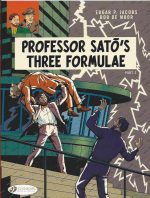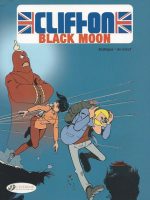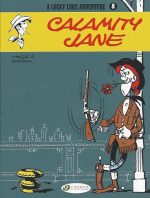
By Derib & Job, coloured by Dominque, translated by Jerome Saincantin (Cinebook)
ISBN: 978-1-84918-101-3
Children’s magazine Le Crapaud à lunettes was founded in 1964 by Swiss journalist André Jobin who then wrote for it under the pseudonym Job. Three years later he hired fellow French-Swiss artist Claude de Ribaupierre who chose the working name “Deribâ€. The illustrator had begun his own career as an assistant at Studio Peyo (home of Les Schtroumpfs), working on Smurfs strips for venerable weekly Spirou. Together they created the splendid Adventures of the Owl Pythagore before striking pure comics gold a few of years later with their next collaboration.
Launched in 1969, Yakari detailed the life of a young Oglala Lakota boy on the Great Plains; sometime after the introduction of horses by the Conquistadores and before the coming of the modern White Man. This year the 39th album was released: a testament to the strip’s evergreen vitality and the quality of its creators.
Overflowing with gentle whimsy, Yakari enjoys a largely bucolic existence; at one with nature and generally free from strife. For the sake of our delectation, however, the ever-changing seasons are punctuated with the odd crisis, generally resolved without fuss, fame or fanfare by a little lad who is smart, compassionate, brave… and can converse with all animals…
Derib – equally at home with enticing, comically dynamic “Marcinelle†cartoon style yarns and devastatingly compelling meta-realistic action illustrated action epics – went on to become one of the Continent’s most prolific and revered creators. It’s a crime that such groundbreaking strips as Celui-qui-est-né-deux-fois, Jo (the first comic on AIDS ever published), Pour toi, Sandra and La Grande Saga Indienne) haven’t been translated into English yet, but we still patiently wait in hope and anticipation…
Many of Derib’s stunning works over the decades feature his beloved Western themes, magnificent geographical backdrops and epic landscapes and Yakari is considered by fans and critics to be the feature which first led him to deserved mega-stardom. Originally released in 1986, Yakari et le coyote was the twelfth European album (and Cinebook’s ninth translated tome), but – as always – is both stunningly simple and effectively timeless; offering certain enjoyment from a minimum of foreknowledge…
One bright sunny day, the boy brave is playing by the river, when his trusty chums the beavers bring him a present. They have found a dilapidated birch-bark canoe and hope Yakari can repair it so they can have some real fun…
Next morning finds the lad and his human friends Rainbow and Buffalo Seed hard at work. Before long the vessel is seaworthy again and the trio are ready for their maiden voyage. As befits a proper hunter, Buffalo Seed insists on bringing his bow and arrows with him…
The current soon catches them and the kids get a huge thrill shooting roaring rapids with no more than a few bumps and a thorough soaking. They continue on in exhilarated contentment, but no one notices that the bellicose little hunter’s moccasins have vanished…
Feeling hungry, they paddle ashore far downstream and begin gathering food, where Rainbow’s search ends in a happy surprise as her foraging uncovers three coyote cubs playing tug-of-war with Buffalo Seed’s shoes. She then endures a far scarier shock when she runs into the cubs’ snarling mother…
Fleeing in terror Rainbow calls for Yakari to explain, but the pups’ magnificent father has already interceded and calmed down his over-protective mate. Admitting to swiping the footwear, the crafty one then invites the children back to meet the family and his great friend and fellow trickster crow…
After a wonderful afternoon of play the children head back to the canoe and Coyote goes hunting, but the humans now have a new problem: Buffalo Seed is missing…
In the morning Rainbow and Yakari are awoken by Coyote, who has news. Their cocky companion tried to hunt a cougar and now the bad-tempered, unreasonable, hungry beast has the human boy trapped in a cave. The foolish hunter had made the great mistake of getting too close to the big cat’s cubs…
Normally, Coyote would handle things, but cougars are their greatest rivals, and this situation needs careful handling…
Leaving Rainbow to watch mother coyote teaching her babies useful survival tricks, Yakari, Crow and Coyote – only stopping infrequently to play a few harmless jests on other animals – pick their way up a rocky cliff face where an extremely irate cat patiently waits for his elected prey to come out of the hole he’s barricaded himself in…
Back at the Sioux encampment, Yakari’s faithful steed Little Thunder had grown concerned. With the children gone for days, the pony broke out of the corral and started tracking them down. Now in the woods below far below, the wonder steed finds Rainbow and the coyote family. However Yakari and the wily papa are elsewhere, facing a rather dangerous impasse…
The irate cougar will not be reasoned with and is determined to kill Buffalo Seed. Thus, unable to overpower the brute, the new companions have devised a risky plan that should draw him away from the cave entrance long enough for the boy to get out. Sadly, even with Coyote and crow distracting the already-angry cat, the real problem will be getting away from the fast-moving hunter, once he notices he’s been fooled…
And then Yakari hears the drumming of hoofbeats…
Superbly suspenseful, joyously inventive and offering a hilarious twist to counter the tension, this is another visually stunning, seductively smart and happily heart-warming saga to delight young and old alike.
Yakari is one of the most unfailingly entertaining all-ages strip every conceived and deserves to be in every home, right beside Tintin and Asterix.
Original edition © Le Lombard (Dargaud- Lombard S. A.) 2000 Derib + Job. English translation 2011 © Cinebook Ltd.









